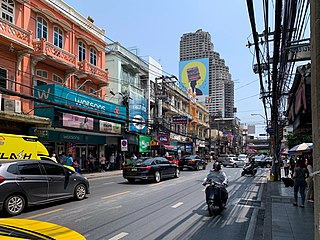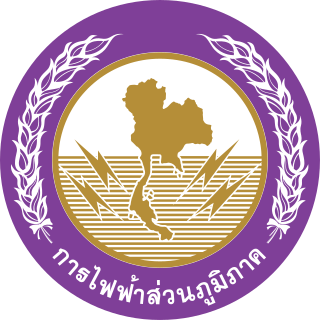
The Bangkok Mass Transit System, commonly known as the BTS Skytrain, is an elevated rapid transit system in Bangkok, Thailand. It is operated by Bangkok Mass Transit System PCL (BTSC), a subsidiary of BTS Group Holdings, under a concession granted by the Bangkok Metropolitan Administration (BMA) which owns the lines. The system consists of 62 stations along three lines with a combined route length of 70.05 kilometers (43.53 mi). The BTS Sukhumvit Line runs northwards and south-eastwards, terminating at Khu Khot and Kheha respectively. The BTS Silom Line which serves Silom and Sathon Roads, the central business district of Bangkok, terminates at National Stadium and Bang Wa. The Gold Line people mover runs from Krung Thon Buri to Klong San and serves Iconsiam. The lines interchange at Siam station and Krung Thon Buri. The system is formally known as "The Elevated Train in Commemoration of HM the King's 6th Cycle Birthday".

Siam Paragon is a shopping mall in Bangkok, Thailand. It is one of the largest malls in Thailand, along with Iconsiam, CentralWorld and Central WestGate.
Siam General Aviation Company Limited was an airline in Thailand. Previously operated as an arm for Nok Air under the brand Nok Mini, the company ended their partnership in March 2014. SGA were in talks to be acquired by Thai AirAsia but this fell through and the airline is no longer operating.

The Somdet Phra Pinklao Bridge is a bridge near the Grand Palace over the Chao Phraya River in Bangkok, Thailand. It links Rattanakosin Island with Thonburi.

The Electricity Generating Authority of Thailand (EGAT) is a state enterprise, managed by the Ministry of Energy, responsible for electric power generation and transmission as well as bulk electric energy sales in Thailand. EGAT, established on 1 May 1969, is the largest power producer in Thailand, owning and operating power plants at 45 sites across the country with a total installed capacity of 15,548 MW.

TOT Public Company Limited is a Thai state-owned telecommunications company. Originally established in 1954 and corporatized in 2002, TOT used to be known as the Telephone Organization of Thailand and TOT Corporation Public Company Limited. TOT's main line of business is fixed line telephony, although it has several other businesses, including mobile telephony. Since 2021, TOT PCL become National Telecom Public Company Limited after merger with CAT Telecom.

CAT Telecom Public Company Limited is the state-owned company that runs Thailand’s international telecommunications infrastructure, including its international gateways, satellite, and submarine cable networks connections. Since 2021 CAT Telecom became the National Telecom Public Company Limited after merging with TOT Public Company Limited.

Bangkok Mass Transit Authority, also known as BMTA, is the main operator of public transit buses within the Greater Bangkok area. It is the largest city bus system in Thailand. The Bangkok Mass Transit Authority offers bus and van routes throughout the city and its suburban provinces.

Charoen Krung Road is a major road in Bangkok and the first in Thailand to be built using modern construction methods. Built during 1862–1864 in the reign of King Mongkut, it runs from the old city centre in Rattanakosin Island, passes through Bangkok's Chinatown, continues into Bang Rak district, where it formerly served the community of European expatriates, and ends in Bang Kho Laem. Construction of the road marked a major change in Bangkok's urban development, with the major mode of transport shifting from water to land. Charoen Krung Road was Bangkok's main street up to the early 20th century, but later declined in prominence. It is still home to many historic buildings and neighbourhoods, which are beset by changes as extension of the underground MRT is poised to drive new development.

Phaya Thai Road is a major road in Bangkok, Thailand. It begins at the south side of Victory Monument in Ratchathewi District and continues until Sam Yan Intersection in Pathum Wan District, where it intersects with Rama IV Road.

TMBThanachart Bank (TTB) is a Thai transactional bank based in Bangkok. It has been listed on the Stock Exchange of Thailand (SET) since 23 December 1983. Piti Tantakasem was appointed CEO effective January 2018.

Andreas du Plessis de Richelieu was a Danish naval officer and businessman who became a Siamese admiral and minister of the navy. He was granted the Thai noble title Phraya Chonlayutthayothin.
Bangkok Mass Transit System Public Company Limited is a Thai transport company, best known as the operator of Bangkok's BTS Skytrain. It is a majority-owned subsidiary of BTS Group Holdings, and also operates the Bangkok BRT and the Gold Line.
The Matchanu class comprised the only four submarines ever employed by the Royal Thai Navy. They were built in Japan by Mitsubishi, and were in commission from 1938 throughout the Franco-Thai war and World War II. The boats were decommissioned following the Manhattan Rebellion in 1951 and the subsequent dissolution of the navy's Submarine Group.

Wind power in Thailand amounted to an installed production capacity of 224.5 MW as of the end of 2014. Installed capacity was 112 MW at the end of 2012, with 111 MW added in 2013, and a minor amount added in 2014. This ranked Thailand 46th in the world by installed capacity as of 2015.

The Metropolitan Electricity Authority (MEA) is a Thai state enterprise under the Ministry of Interior. It was established on 1 August 1958 by the Metropolitan Electricity Authority Act 1958. Its governor is Mr Somchai Roadrungwasinkul.

The Provincial Electricity Authority (PEA) is a Thai state enterprise under the Ministry of Interior. Established on 28 September 1960 by the Provincial Electricity Authority Act 1960 —which are served by the Metropolitan Electricity Authority.

The Bangkok tram system (รถรางกรุงเทพ) was a transport system in Bangkok, Thailand. Its first-generation tram network first operated as a horse tram system, and was eventually converted to electric trams in the late nineteenth century.
Akom Preedakul, known by stage name Kom Chuanchuen, was a Thai comedian and actor best known from comedic, supporting roles in Thai movies and television.
A corporate merger between True Corporation and DTAC, Thailand's second- and third–largest mobile network operators, has been in progress since its first public announcement on 22 November 2021. The deal, which would make the combined entity the largest mobile network ahead of current market leader AIS and reduce the mobile provider market to a duopoly, has been strongly opposed by academics and civil society groups as detrimental to consumers and the public interest. The National Broadcasting and Telecommunications Commission (NBTC) acknowledged the merger with certain conditions on 20 October 2022, though there had been some legal uncertainty over whether the NBTC had authority to approve such a merger and whether the Trade Competition Commission should be involved. Petitions challenging the decision were made to the Administrative Court in November, by the Thailand Consumers Council and AIS.

















